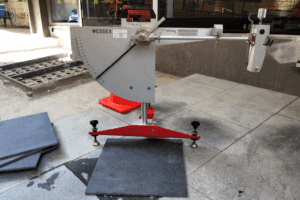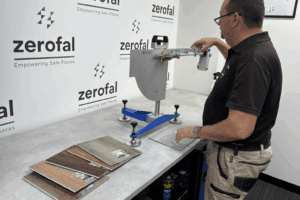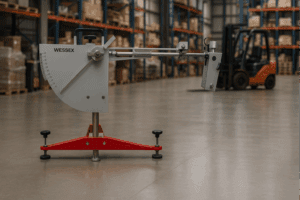What actually happens in a Slip Test Lab?
Inside an Australian Slip Test Lab: What to Expect
From sample preparation to wet pendulum measurements, this article explains the full slip test lab process—so you know exactly how safety is verified under AS 4586. If you’re sending in tiles for certification, here’s what happens next.
If you’ve ever been handed a slip test report stamped “AS 4586-compliant,” you might assume it came from a high-tech lab—and you’d be right. But what actually happens between the moment your tile sample arrives and the moment that report lands in your inbox?
At Zerofal, we specialise in slip resistance testing for new surfaces under AS 4586-2013, the national standard. Here’s how it works.
Step 1: We Log and Inspect Your Sample
Every product is photographed, labelled, and checked for damage. We confirm surface type, size, and whether the sample was prepared or supplied raw.
Step 2: We Choose the Right Test Method
AS 4586-2013 includes four main methods:
- Wet Pendulum (P0–P5): For wet areas like bathrooms or foyers
- Dry Floor Friction (D0 or D1): For dry-only surfaces
- Oil Wet Ramp and
- Wet Barefoot Ramp
Zerofal offers Pendulum and/or Dry Friction tests which suit the vast majority of situations.
Step 3: The Test Begins
We use:
- The Portable Skid Resistance Tester (pendulums) for wet tests
- The Tortus III dry friction tester for dry areas
Each test is performed under controlled lab conditions, with rubber sliders conditioned to the standard and calibrated devices inspected regularly.
Step 4: Results Are Analysed and Rounded
The average result is calculated and classified:
- Wet Pendulum: P0 to P5
- Dry Friction: D0 (fail) or D1 (pass)
Results are rounded per standard, and cross-checked and authorised.
Step 5: We Issue a NATA-Traceable Report
Every report includes test conditions, methods used, photos, and results. It’s ready for compliance documentation and audit.
Why It Matters
Not all slip test labs are accredited or independent. Some use uncalibrated gear or mix field and lab protocols. We don’t.
Zerofal delivers certified, impartial testing that meets legal and technical standards—and gives your project real protection.
Need a Certified Slip Test?
If you’re supplying tiles or coatings, an AS 4586 lab report can be the difference between approval and delay. Send your samples to Zerofal and get fast, certifiable results you can trust.
Explore more

Colour, Grit and Surface Finish: How Subtle Differences Change Slip Ratings (AS 4586:2013)
Colour, grit and finish change slip resistance. Learn why P-ratings vary across tile ranges and coatings

Why One Slip Test Isn’t Enough for Product Lines (AS 4586:2013)
Slip resistance varies across colours and finishes. Learn why one AS 4586 test cannot certify an entire product line.

Industrial Slip Resistance: Dust, Boots & Coating Drift (AS 4663:2013)
: Industrial floors change fast. Learn how dust, coatings and machinery reduce slip resistance and why AS 4663 onsite testing is essential.
Stay Ahead of Safety Standards
Join the Zerofal newsletter for actionable insights on slip testing, compliance updates, and smart prevention strategies. No spam – just practical safety advice.
